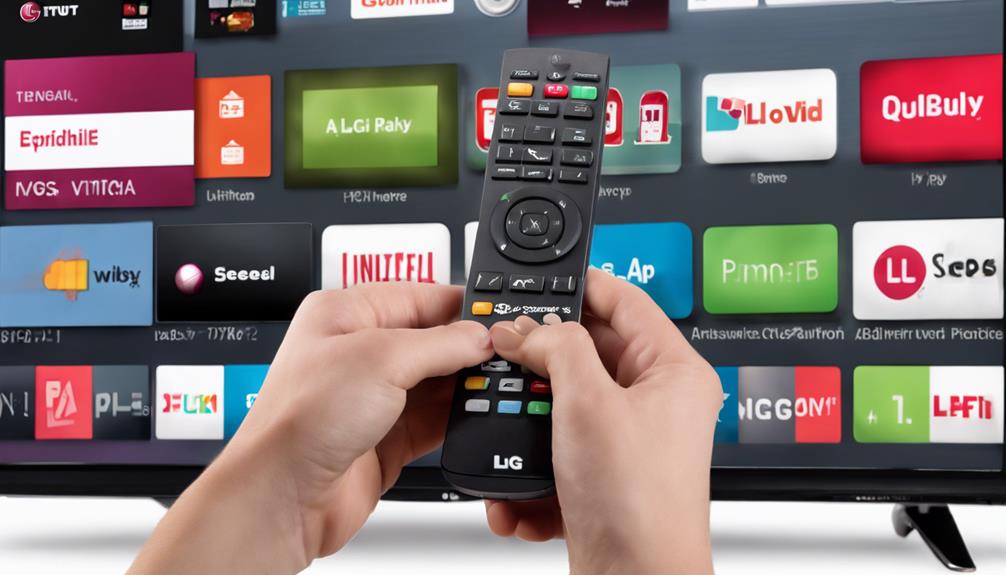When it comes to navigating the realm of installing 3rd party apps on your LG Smart TV, it's like embarking on a quest for hidden treasures.
Wondering how to embark on this journey and unlock the full potential of your TV? Stay tuned as we unveil the secrets to expanding your LG Smart TV's capabilities with a variety of apps beyond the standard offerings.
Key Takeaways
- Incorporating 3rd party apps expands LG TV functionality and customization.
- LG TV Remote Control Plus offers convenient and enhanced user experience.
- AirBeamTV Mirror enhances viewing with high-definition screen mirroring.
- Aptoide TV provides a wide variety of unique apps tailored for LG Smart TVs.
Benefits of 3rd Party Apps on LG TV
By incorporating 3rd party apps on your LG TV, you unlock a myriad of benefits that expand the functionality and customization of your viewing experience. LG Smart TVs offer users the ability to install 3rd party apps, providing access to a wide range of apps beyond what comes pre-installed. These additional apps not only enhance the user experience but also offer extensive customization options. With free entertainment options available through these apps, users can enjoy a variety of content without incurring extra costs.
The installation of 3rd party apps on LG TV sets opens up new possibilities for users to tailor their viewing experience to their preferences. These apps can significantly enhance the overall functionality of the TV by improving video and audio quality while offering unique features not found in standard pre-installed apps. Exploring the world of 3rd party apps on your LG TV can lead to a more personalized and enjoyable entertainment experience.
LG TV Remote Control Plus
LG TV Remote Control Plus enhances control of your LG Smart TV through its App Launcher, Keyboard, and Trackpad functionalities, providing seamless navigation and interaction options.
- Convenient Control: Access various functions and settings on your LG Smart TV conveniently from your mobile device.
- Enhanced User Experience: Enjoy easy navigation and interaction with your LG TV, improving your overall viewing experience.
- Seamless Connectivity: Connect your smartphone or tablet effortlessly to your LG Smart TV for added convenience.
- Simplified Operation: Manage your viewing experience with ease using the LG TV Remote Control Plus app.
This app from the LG Content Store simplifies the operation of your LG Smart TV, offering a range of features that make controlling your TV more intuitive.
AirBeamTV Mirror for LG TV
Enhance your LG Smart TV viewing experience with the seamless screen mirroring capabilities of AirBeamTV Mirror. This app offers high-definition streaming quality, ensuring a premium viewing experience free from ads.
With AirBeamTV Mirror, you can effortlessly mirror your devices to your LG Smart TV, allowing for easy sharing of content. The app provides seamless connectivity, supporting a variety of devices such as iPhones, iPads, and Mac computers, offering versatile options for screen mirroring.
Enjoy wireless and hassle-free screen mirroring with AirBeamTV Mirror, requiring minimal setup while providing maximum entertainment value.
Elevate your LG Smart TV entertainment by leveraging the convenience and flexibility of AirBeamTV Mirror to connect and share content from a wide array of devices. Experience the benefits of high-quality screen mirroring and versatile connectivity options with AirBeamTV Mirror for LG TV.
Aptoide TV
To access a diverse selection of third-party apps on your LG Smart TV, consider installing Aptoide TV, a popular alternative app store. Aptoide TV is specifically tailored for LG Smart TVs, offering a vast array of apps that may not be found on the official LG Content Store. Here's why you should consider Aptoide TV:
- Wide Variety: Aptoide TV provides a wide variety of apps, expanding your options beyond the standard LG offerings.
- Unique Content: Users can explore and download apps from Aptoide TV, discovering unique content that adds value to their smart TV experience.
- Developer Platform: It serves as a platform for developers to showcase their apps, ensuring constant updates and fresh content for users.
- Enhanced Customization: Installing Aptoide TV on your LG Smart TV opens up new customization possibilities, allowing you to tailor your smart TV experience to your preferences.
FileLinked
By utilizing FileLinked on your LG Smart TV, you can efficiently access a variety of apps and files through unique codes. FileLinked serves as a centralized platform that simplifies the process of installing multiple apps on your TV. You have the flexibility to create your personalized FileLinked codes or utilize codes shared by others to swiftly install apps on your LG Smart TV. This app provides a convenient way to discover and install third-party apps that may not be readily available on the official LG Content Store, expanding the functionality of your smart TV. It is a popular choice among users seeking a wide range of downloadable apps for their LG Smart TV.
| FileLinked on LG Smart TV | |
|---|---|
| Functionality | Centralized platform for app installation |
| Usage | Access third-party apps through unique codes |
| Benefits | Discover and install a variety of apps efficiently |
Kodi
Explore the versatility and convenience of using Kodi on your LG Smart TV to unlock a world of entertainment possibilities. Kodi is a powerful media center application that transforms your LG Smart TV into a hub for streaming a wide variety of content. Here are four key features of Kodi:
- Media Center Excellence: Kodi serves as a comprehensive media center, allowing you to organize and access your favorite movies, TV shows, music, and more, all from the comfort of your LG Smart TV.
- Customizable Add-Ons: Enhance your entertainment experience by utilizing Kodi's vast array of add-ons, which provide additional features and customization options tailored to your preferences.
- Seamless Streaming: With Kodi on your LG Smart TV, enjoy seamless streaming of content from various sources, ensuring you never run out of things to watch.
- Cost-Effective Entertainment: Kodi is a free application, making it a cost-effective solution for transforming your LG Smart TV into a personalized entertainment hub. Experience personalized playlists, live TV streaming, and access to online content with Kodi.
How to Install 3rd Party Apps
Discover how to effortlessly add 3rd party apps to your LG Smart TV for a customized viewing experience.
To install 3rd party apps on your LG Smart TV, you have two main options. First, you can explore the LG Content Store on your TV, where you may find select 3rd party apps available for download.
If the desired app isn't in the LG Content Store, you can use a USB drive to sideload the app onto your TV. This involves downloading the APK file of the app onto a USB drive from a trusted source and then plugging the USB drive into your LG Smart TV to install the app.
Remember that LG Smart TVs don't support the Google Play Store, so these methods are essential for expanding your app selection. Ensure your TV is connected to the internet before attempting to download any 3rd party apps and exercise caution to avoid potential security risks associated with installing apps from unknown sources.
Frequently Asked Questions
Can I Install Third-Party Apps on LG Smart Tv?
Yes, you can install third-party apps on LG Smart TVs. Ensure app compatibility, manage permissions, and stay cautious of security risks. Explore LG app store alternatives, sideloading, and update processes for a customized experience.
How Do I Add Apps to My LG Smart TV That Are Not Listed?
To add apps not listed on your LG Smart TV, you can sideload them via USB, explore app store alternatives like Aptoide TV, cast from your phone, install through the browser, or consider a VPN for wider access.
How Do I Install Apps From Unknown Sources on My LG Smart Tv?
When installing apps from unknown sources on your LG Smart TV, ensure you understand the risks. Side loading apps can expose you to security risks and void warranties. Check app permissions, compatibility, and updates for a smoother experience.
How Do I Download Android Apps to My LG Smart Tv?
To download Android apps on your LG Smart TV, go to the Apps section and search for your desired app. Follow on-screen prompts for quick installation. Enjoy a world of entertainment with popular apps like Netflix and Spotify.





